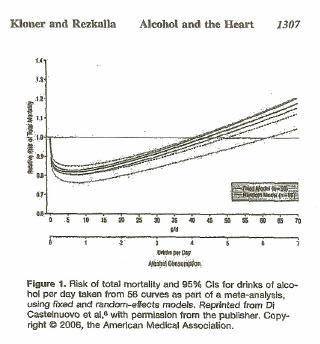To Drink or Not to Drink?
A large review of the medical literature on the health benefits of alcohol was published recently in the
medical journal, Circulation (2007;116:1306-1317). The report was from the Heart Institute, Good
Samaritan Hospital, and the Division of Cardiovascular Medicine, Keck School of Medicine, University
of Southern California, Los Angeles and the Department of Cardiology, Marshfield Clinic, Marshfield,
Wisconsin. The article is titled, “To Drink or Nor to Drink? That is the Question.” The authors are
Robert A. Kloner, MD, PhD and Shereif H. Rezkalia, MD.
As the authors point out, the scientific debate over the health risks and benefits of alcohol dates back
several centuries starting in Europe and continuing to the present time. All of the studies to date are
observational and epidemiological. There has been no long-term prospective, randomized trial in
which one group abstains and a second group receives 1 drink of alcohol, perhaps as red wine, once a
day or once every other day, and followed long term. That said, there are many studies that have
shown a J-shaped or U-shaped curve to describe the relationship between alcohol use and total
mortality (see figure below). The optimal benefit of alcohol occurs at approximately a ½ a drink per
day. Less than 4 drinks per day in men and fewer than 2 drinks per day in women appear to bestow
benefit. Beyond these amounts, there is an increased mortality.

In the United States, a standard alcoholic drink is a 12 oz of beer, 5 oz of wine, or 1.5 oz of 80 proof
spirits or liquor. Some studies have shown an advantage of wine over other types of alcoholic
beverages, but other research indicates that the type of drink is not important.
The overwhelming majority of data indicates that moderate drinking benefits the cardiovascular
system. Light drinking has no current definition but is presumably less than moderate drinking.
Moderate drinking is defined as no more than 1 drink per day for women and no more than 2 drinks
per day for men. Heavy drinking is more than 1 drink per day for women and more than 2 drinks per
day for men. Binge drinking, which is clearly unhealthy, is more than 3 drinks for women and more
than 4 drinks for men on a single occasion over 2 hours.
At least a portion of the benefit of alcohol is due to decreased coronary artery disease deaths. Light to
moderate drinking has many beneficial effects on the cardiovascular system and the proposed
mechanisms include: increased high-density lipoprotein cholesterol (HDL), decreased plasma
viscosity, increased fibrinolysis, decreased platelet aggregation, improved vascular endothelial lining
function, decreased vascular inflammation, and beneficial antioxidant effects. These benefits translate
to: decreased cardiovascular death, decreased nonfatal myocardial infarction, decreased
development of heart failure (and no exacerbation of heart failure) in patients with underlying heart
failure, decreased coronary heart disease, and decreased total mortality.
Heavy drinking is associated with many harmful effects: increased mortality, high blood pressure,
alcoholic cardiomyopathy, ventricular arrythmias, hemorrhagic stroke, cirrhosis, diabetes, cancer and
unnatural and sudden death.
There is one significant issue with regard to women and drinking that has not been resolved. Until
recently, some research had shown that there was a 10% increase in breast cancer in women who had
light to moderate intake of alcohol. However, middle-aged and older women with adequate folic acid
(found in leafy greens, citrus fruits, beans and peas) in their diet and were not on hormone
replacement therapy had the same incidence of breast cancer in light to moderate drinkers of wine as
abstainers. One caveat is that breast cancer is not the number one killer of women as many people
believe. Cardiovascular disease is the major cause of death in women and research has shown that
there is a 50% reduction in cardiovascular disease in women who are light to moderate wine drinkers.
A recent study by researchers at the Kaiser Permanente Division of Research in Oakland, California,
led by noted authority on the health benefits of alcohol, Dr. Arthur Klatsky, confirmed a higher risk of
breast cancer in women who were moderate drinkers . At the European Cancer Conference held in
late September in Barcelona, Spain, Klatsky reported that women who drank one or two drinks a day
increased their risk of breast cancer by 10%, compared to light drinkers (less than 1 drink a day). The
risk increased to 30% in women who drank more than 3 drinks per day, whether the drink of choice
was wine, beer or liquor. This 30% increased risk is comparable to the risk exposure of women who
smoke a pack of cigarettes a day or take estrogenic hormones. Epidemiological research studies like
Klatsky reported are often flawed by residual confounding (an unmeasurable factor). The group of
women in this study were mostly affluent and well-educated women who drank a lot of white wine. It is
known that it is polyphenols found in red wine that confer protection against cancer.

The issues involved in the health benefits of alcohol are all very
convoluted and complex. Until the defintive word comes out, do as I do,
drink 2 glasses of Pinot Noir every day with dinner. And have your wife
do as mine does, drink 1 glass of Pinot Noir every day with dinner. I
should also add that I frequently bath in Pinot Noir but you may not want
to try this at home.
Circulation is available at www.circ.ahajournals.org.